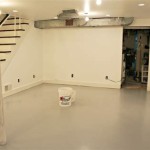Concrete Sealer For Basement Floor
Concrete sealers are an essential part of maintaining a basement floor. They help to protect the concrete from moisture and chemicals, and they can also make the floor more durable and easier to clean. There are many different types of concrete sealers available, so it's important to choose the right one for your needs.
The most common type of concrete sealer is a penetrating sealer. Penetrating sealers soak into the concrete and create a barrier that prevents moisture and chemicals from entering. They are the most effective type of sealer for protecting concrete from damage, but they can be more expensive than other types of sealers.
Another type of concrete sealer is a topical sealer. Topical sealers sit on the surface of the concrete and create a barrier that prevents moisture and chemicals from entering. They are not as effective as penetrating sealers at protecting concrete from damage, but they are less expensive and easier to apply.
When choosing a concrete sealer, it's important to consider the following factors:
- The type of concrete. There are different types of concrete, including regular concrete, polished concrete, and stamped concrete. Some sealers are designed specifically for certain types of concrete, so it's important to choose the right one for your floor.
- The condition of the concrete. If the concrete is in good condition, you may be able to use a less expensive topical sealer. However, if the concrete is damaged or cracked, you may need to use a more expensive penetrating sealer.
- The desired finish. Some sealers create a glossy finish, while others create a matte finish. Choose the finish that you prefer.
Once you've chosen a concrete sealer, it's important to apply it correctly. The following steps will help you to apply a concrete sealer correctly:
- Clean the concrete. Remove all dirt, dust, and debris from the concrete. You can use a broom, a mop, or a pressure washer to clean the concrete.
- Allow the concrete to dry. Once the concrete is clean, allow it to dry completely. This may take several hours or even days, depending on the weather.
- Apply the sealer. Apply the sealer according to the manufacturer's instructions. Most sealers are applied with a roller or a brush.
- Allow the sealer to dry. Once the sealer has been applied, allow it to dry completely. This may take several hours or even days, depending on the sealer and the weather.
Once the sealer has dried, your concrete floor will be protected from moisture and chemicals. You can now enjoy your beautiful, durable floor for many years to come.

Alternative Finishes For Interior Concrete Floors Decor

Colored Concrete Sealer How To Guide

Seal Your Concrete Basement Driveway Bricks Radonseal

A Guide To Stained Concrete Basement Floors

Basement Concrete Floor Coatings Better Than Flooring

Basement Floor Coating Waterproof Flooring Paint Durall Concrete Coatings

Radonseal Standard Concrete Sealer

Polished Concrete Flooring Options For Your Basement Duraamen

Concrete Floor Coating Waterproofing Sealing Systems

Internal Concrete Sealer For Floors Walls Sidewalks More Timber Pro Uv








